Apple Macintosh Powermac Performa WS7250 Service Manual

K Service Source
Power Macintosh 7200
Series/WS 7250
Power Macintosh 7200/75, 7200/90, 7200/120 and
WS 7250/120

K Service Source
Basics
Power Macintosh 7200 Series/
WS 7250

Basics |
Overview - 1 |
|
|
|
|
Overview
The chassis design of the Power Macintosh 7200 Series and WS 7250 computers allows you to access the logic board and its components without having to remove the power supply or any drives. This flexible design makes these computers easier to service and upgrade.
Features of the Power Macintosh 7200 Series include
•A 75, 90, or 120 MHz PowerPC™ 601 microprocessor with built-in FPU and optional Level 2 cache
•Three PCI expansion slots
•5 MB per second internal and external SCSI channels
•DRAM expansion up to 256 MB using 168-pin, 70 ns, 64-bit DIMMs
•1 MB of soldered VRAM, expandable to 2 or 4 MB
•Built-in AAUI and 10BASE-T Ethernet
•Two GeoPort serial ports

Basics |
Overview - 2 |
|
|
|
|
|
• AppleCD™ 600i or 1200i CD-ROM drive |
|
|
• CD-quality stereo sound in/out |
|
|
• Optional PC Compatibility Card (Power Macintosh |
|
|
7200/120) |
|
|
• Mac™ OS system software 7.5.2 (7200/75 and |
|
|
7200/90), system software7.5.3 (7200/120), and |
|
|
system software7.5.3 Revision 2 (7200/120 8x-CD) |
|
|
Note: VRAM expansion works as follows: 1 MB of VRAM is |
|
|
soldered to the board. To go to 2 MB, install one 1 MB VRAM |
|
|
DIMM in slot 1. To go to 4 MB, install three 1MB VRAM |
|
|
DIMMs in slots 1, 2, and 3. |
|
Features of the Workgroup Server 7250/120 include
•A 120 MHz PowerPC™ 601 microprocessor with builtin FPU and 32K on-chip cache
•256K level 2 cache
•16 MB of DRAM, expandable to 256 MB

Basics |
Overview - 3 |
|
|
|
|
|
• Three PCI expansion slots |
|
|
• SCSI DMA bus that supports up to four external and |
|
|
three internal SCSI devices |
|
|
• Built-in AAUI and 10BASE-T Ethernet support |
|
|
• Support for AppleTalk and TCP/IP networking protocols |
|
|
• Two GeoPort serial ports |
|
|
• 1.2 GB or 2 GB hard drive |
|
|
• AppleCD™ 600i or 1200i CD-ROM drive |
|
|
• 16-bit stereo sound input/output |
|
|
• 1 MB of soldered VRAM |
|
|
• Mac™ OS system software 7.5.3 Revision 2 |
|
|
The Power Macintosh 7200 and WS 7250 computer is |
|
|
pictured on the following page. |
|
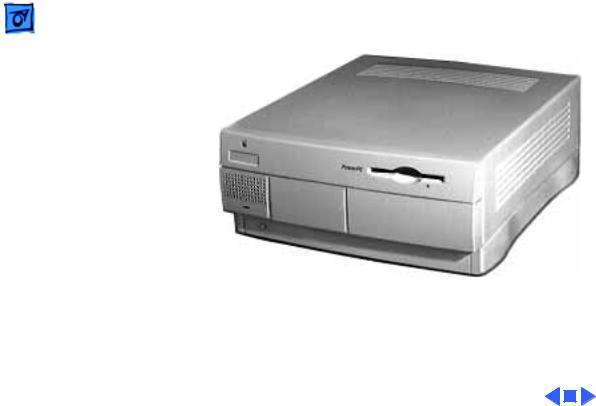
Basics |
Overview - 4 |
|
|
|
|
Power Macintosh 7200 and WS 7250 Computer

Basics |
Configurations - 5 |
|
|
|
|
Configurations
The Power Macintosh 7200 Series computers come standard with
•75, 90, or 120 MHz PowerPC 601 microprocessor
•8 or 16 MB DRAM
•500 MB or 1.2 GB hard drive
•AppleCD 600i CD-ROM (7200/75, 7200/90, and 7200/120) or 1200i CD-ROM (7200/120 8x-CD)
•1 MB of VRAM soldered to the logic board
The WS 7250/120 computer comes standard with
•120 MHz PowerPC 601 microprocessor
•16 MB DRAM
•1.2 GB or 2 GB hard drive
•AppleCD 600i or 1200i CD-ROM drive
•1 MB of VRAM soldered to the logic board

Basics |
PowerPC 601 Microprocessor - 6 |
|
|
|
|
PowerPC 601 Microprocessor
The Power Macintosh 7200 Series and WS 7250 computers feature the PowerPC 601 RISC microprocessor. Features of this microprocessor include
•Full RISC processor architecture
•32-bit addressing
•64-bit data bus
•Built-in FPU
•32K cache for data and instructions
•Internal Memory Management Unit (MMU)
•Advanced branching techniques for improved throughput

Basics |
Peripheral Component Interconnect (PCI) - 7 |
|
|
|
|
Peripheral Component Interconnect (PCI)
The Power Macintosh 7200 Series and WS 7250 computers offer a Peripheral Component Interconnect (PCI) expansion bus. Because the PCI bus is an industry standard, most existing PCI 2.0-compliant cards (with the addition of a Mac OS-specific software driver) will work in these computers.
PCI offers significantly higher performance than the NuBus architecture used in previous Macintosh models. Running at 33 MHz, the PCI bus is up to three times faster than NuBus, offering overall enhanced system performance, particularly in the areas of video and networking.

Basics |
Dual In-Line Memory Modules (DIMMs) - 8 |
|
|
|
|
Dual In-Line Memory Modules (DIMMs)
The Power Macintosh 7200 Series and WS 7250 computers use DRAM Dual In-Line Memory Modules (DIMMs) instead of DRAM SIMMs. Whereas SIMMs have 72 pins, DIMMs have 168 pins. The extra pins provide a 64-bit data path, compared to a 32-bit data path for SIMMs. In addition, DIMMs do not have to be installed in pairs like the SIMMs on earlier Macintosh models.
Important: The VRAM and DRAM Single In-Line Memory Modules (SIMMs) used in previous Macintosh models are not compatible with the Power Macintosh 7200 Series and WS 7250 computers.

Basics |
Memory Configurations - 9 |
|
|
|
|
Memory Configurations
The Power Macintosh 7200 and WS 7250 logic boards have four DRAM DIMM slots, each with a 64-bit data bus. You can increase the computer’s DRAM to a total of 256 MB using 5- volt, 64-bit-wide, 168-pin fast-paged mode, 70 ns DIMMs.
Note: These computers do not have any main memory soldered to the logic board. At least one DRAM DIMM must be present for the computer to operate.
DRAM DIMMs can be installed individually or in pairs. These computers support linear memory only; therefore, no memory gains are seen when two DIMMs of the same size are installed (that is, memory interleaving is not supported on the Power Macintosh 7200 Series/WS 7250 computers).

Basics |
Memory Configurations - 10 |
|
|
|
|
Note |
DIMMs purchased from different manufacturers can |
|
be paired; However, Apple recommends that you use DIMMs |
||
of the same size and speed. |
||
The drawing on the next page illustrates where the DRAM slots are located on the Power Macintosh 7200 Series/WS 7250 logic boards and how they are numbered. DRAM can be installed in any order.
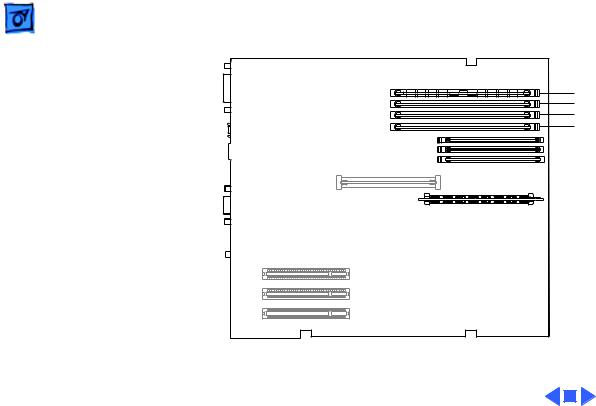
Basics |
Memory Configurations - 11 |
|
|
|
|
4
3
2
1
Figure: DRAM DIMM Slots

Basics |
Ethernet Support - 12 |
|
|
|
|
Ethernet Support
There are two Ethernet ports on the Power Macintosh 7200 Series and WS 7250 logic boards: an AAUI port and a 10BASE-T port. You can use only one Ethernet port at one time, however. If you have cables plugged into both Ethernet ports, the computer uses the 10BASE-T port by default.
GeoPort
Geoport is a hardware and software communications architecture that has been optimized for computertelephony integration. It has three main attributes:
•It lets any computer connect to any telephone (analog or digital, public or private) anywhere in the world.

Basics |
GeoPort - 13 |
|||
|
|
|
||
|
• Once connected, it supports an arbitrary number of |
|||
|
independent data streams up to a total bandwidth of 2 MB/ |
|||
|
second. |
|||
|
• Unlike traditional asynchronous data communications |
|||
|
(such as AppleTalk), GeoPort also supports isochronous |
|||
|
data streams (such as real-time voice and video) and |
|||
|
provides the real-time Application Program Interfaces |
|||
|
(APIs) necessary to hide the implementation details |
|||
|
from both the recipient and the sender. |
|||
|
By attaching an Apple GeoPort Telecom Adapter to the Power |
|||
|
Macintosh 7200 or WS 7250, you can enjoy all the features |
|||
|
of a 14.4 modem, including data, fax, send and receive, and |
|||
|
voice capabilities. The GeoPort Telecom Adapter serves as a |
|||
|
line interface to standard (analog) telephone lines. The |
|||
|
adapter is capable of sending or receiving data at up to 14.4 |
|||
|
kbps and faxes at up to 9600 bps using the GeoPort Telecom |
|||
|
Adapter software. |
|||
|
|
|
|
|
|
|
|
|
|

Basics |
PC Compatibility Cards - 14 |
|
|
|
|
PC Compatibility Cards
The Power Macintosh 7200/120 features an optional PC Compatibility card, which brings full DOS functionality to the Macintosh computer. Two versions of the PC Compatibility card are available: a 7" card and a 12" card. The cards plug into any available PCI slot on the logic board.
The two PC Compatibility cards are also available in individual upgrade kits. Refer to the Upgrades chapter in this manual for installation instructions.

 Basics The Cuda Chip - 15
Basics The Cuda Chip - 15
The Cuda Chip
The Cuda is a microcontroller chip. Its function is to
• Turn system power on and off
• Manage system resets from various commands
• Maintain parameter RAM (PRAM)
• Manage the Apple Desktop Bus (ADB)
• Manage the real-time clock
Many system problems can be resolved by resetting the Cuda chip (see Symptom Charts for examples). Press the Cuda reset button on the logic board to reset the Cuda chip. (See "Logic Board Diagram" later in this chapter to locate the Cuda reset button.) If you continue to experience system problems, refer to "Resetting the Logic Board" later in this Basics chapter.

Basics |
Resetting the Logic Board - 16 |
|
|
|
|
Resetting the Logic Board
Resetting the logic board can resolve many system problems (refer to "Symptom Charts" for examples). Whenever you have a unit that fails to power up, you should follow this procedure before replacing any modules.
1Unplug the computer.
2Remove the battery from the logic board. (See Take Apart for instructions on how to remove the battery.)
3Disconnect the power supply cable from the logic board and then press the Power On button. (See "Logic Board Diagram" later in this chapter to locate the Power On button.)
4Wait at least 10 minutes before replacing the battery. Make sure the battery is installed in the correct +/- direction.

Basics |
Resetting the Logic Board - 17 |
|||
|
|
|
||
|
5 Reassemble the computer and test the unit. |
|||
|
Note: This procedure resets the computer’s PRAM. Be sure |
|||
|
to check the computer’s time/date and other system |
|||
|
parameter settings afterwards. |
|||
|
Note: If this procedure resolves the problem, claim an |
|||
|
adjustment on an SRO. If not, replace the defective |
|||
|
component and DO NOT claim the adjustment procedure. |
|||
|
|
|
|
|
|
|
|
|
|

Basics |
Rear View Diagram - 18 |
|
|
|
|
Rear View Diagram
The Power Macintosh 7200 Series and WS 7250 computers offer the following external ports: SCSI, AAUI Ethernet, 10BASE-T Ethernet, serial printer (GeoPort compatible), serial modem (GeoPort compatible), DB-15 video, ADB, sound input, and sound output.
The drawing on the next page illustrates the external ports on the Power Macintosh 7200 Series and WS 7250 computers.
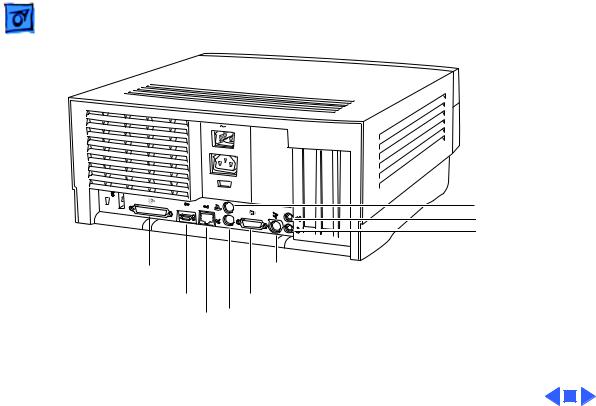
Basics |
Rear View Diagram - 19 |
|
|
|
|
Printer
Sound Out
Sound In
SCSI |
|
|
|
|
|
ADB |
AAUI |
|
|
|
|
|
Monitor |
|
|
|
|
|
||
Ethernet |
|
|
|
Modem |
||
|
|
|
||||
|
10BASE-T |
|||||
|
Ethernet |
|||||
Figure: Power Macintosh 7200 and WS 7250 Rear Panel

Basics |
Power Macintosh 7200 Logic Board Diagram - 20 |
|
|
|
|
Power Macintosh 7200 Logic Board Diagram
There are five versions of the Power Macintosh 7200 logic board: one 75 MHz version, two 90 MHz versions, and two 120 MHz versions. The two 90 MHz versions of the logic board are functionally equivalent, as are the two 120 MHz versions; However, one of the 90 MHz versions and one of the 120 MHz versions has an auxiliary fan that connects at J70.
Important: Do not unplug the Peltier device (one red wire and one black wire) that runs from the processor to the logic board or you will damage the board.
The following drawing shows the Power Macintosh 7200 logic board. Refer to the parts chapter for information on how you can distinguish between the different logic boards.
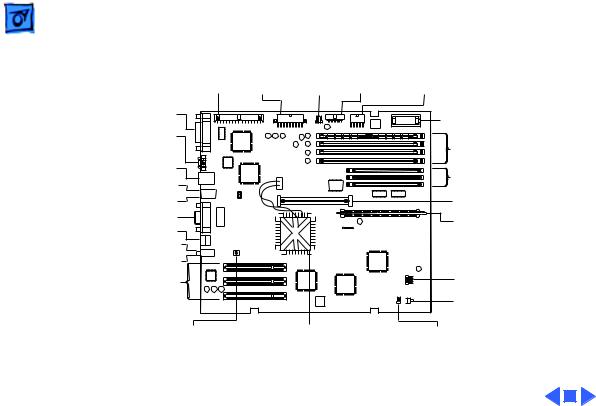
Basics |
Power Macintosh 7200 Logic Board Diagram - 21 |
||||
|
|
|
|
|
|
Internal |
Power |
CD |
Floppy |
3.3V Power |
|
SCSI |
Supply |
Audio |
Drive |
Supply |
|
External SCSI |
|
|
Battery |
|
|
|
|
AAUI Ethernet |
|
4 |
|
10BASE-T |
|
3 |
DRAM Slots |
|
2 |
||
|
1 |
|
|
Ethernet |
|
|
|
|
3 |
VRAM Slots |
|
Modem (bottom) |
|
2 |
|
|
1 |
|
|
Printer (top) |
|
|
Cache DIMM |
Video |
|
|
ROM SIMM |
ADB |
|
|
|
|
|
|
|
Sound Out (top) |
|
|
|
Sound In (bottom) |
|
|
|
PCI Slots |
|
|
Power LED |
|
|
|
Power |
|
|
|
On/Off |
Cuda Reset |
PowerPC 601 Processor |
Speaker |
|
Figure: Power Macintosh 7200 Logic Board

Basics |
Workgroup Server 7250 Logic Board Diagram - 22 |
|
|
|
|
Workgroup Server 7250 Logic Board Diagram
There is only one version of the WS 7250 logic board, which features a 120 MHz microprocessor. This board does not require an auxiliary processor fan.
The following drawing shows the WS 7250 logic board. Note: Some versions of the logic board have a ROM SIMM while others have the ROM soldered on the logic board.
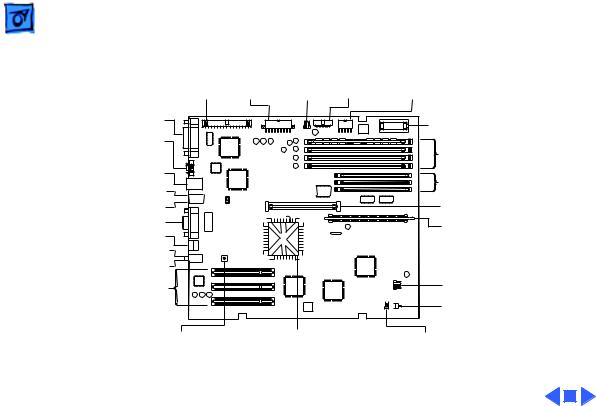
Basics |
Workgroup Server 7250 Logic Board Diagram - 23 |
||||
|
|
|
|
|
|
Internal |
Power |
CD |
Floppy |
3.3V Power |
|
SCSI |
Supply |
Audio |
Drive |
Supply |
|
External SCSI |
|
|
Battery |
|
|
|
|
AAUI Ethernet |
|
4 |
|
10BASE-T |
|
3 |
DRAM Slots |
|
2 |
||
|
1 |
|
|
Ethernet |
|
|
|
|
3 |
VRAM Slots |
|
Modem (bottom) |
|
2 |
|
|
1 |
|
|
Printer (top) |
|
|
Cache DIMM |
Video |
|
|
ROM SIMM |
ADB |
|
|
|
|
|
|
|
Sound Out (top) |
|
|
|
Sound In (bottom) |
|
|
|
PCI Slots |
|
|
Power LED |
|
|
|
Power |
|
|
|
On/Off |
Cuda Reset |
PowerPC 601 Processor |
Speaker |
|
Figure: Workgroup Server 7250 Logic Board

Basics |
Repair Strategy - 24 |
|
|
|
|
Repair Strategy
Service the Power Macintosh 7200 Series and WS 7250 computers through module exchange and parts replacement. Customers can request on-site service from an Apple Authorized Service Provider Plus (AASP+) or Apple Assurance. They can also choose carry-in service from an AASP.
Ordering
Apple Service Providers planning to support the Power Macintosh 7200 Series and WS 7250 computers may purchase Service modules and parts to develop servicing capability. To order parts, use the AppleOrder system and refer to the Power Macintosh 7200 or Workgroup Server 7250 "Service Price Pages."

Basics |
Ordering - 25 |
|||
|
|
|
||
|
Large businesses, universities, and K-12 accounts must |
|||
|
provide a purchase order on all transactions, including |
|||
|
orders placed through the AppleOrder system. Service |
|||
|
providers not enrolled in AppleOrder may fax their orders |
|||
|
to Service Provider Support (512-908-8125) or mail |
|||
|
them to |
|||
|
Apple Computer, Inc. |
|||
|
Service Provider Support |
|||
|
MS 212-SPS |
|||
|
Austin, TX 78714-9125 |
|||
|
If you have further questions, please call Service Provider |
|||
|
Support at 800-919-2775 and select option #1. |
|||
|
|
|
|
|
|
|
|
|
|

Basics |
Warranty and AppleCare - 26 |
|
|
|
|
Warranty and AppleCare
The Power Macintosh 7200 Series and WS 7250 computers are covered under the Apple One-Year Limited Warranty. The AppleCare Service Plan is also available for these products. Service Providers are reimbursed for warranty and AppleCare repairs made to these computers. For pricing information, refer to "Service Price Pages."

K Service Source
Specifications
Power Macintosh 7200 Series/
WS 7250

Specifications |
Processor - 1 |
|
|
|
|
Processor
CPU
PM 7200/75 and 7200/90
PM 7200/120 and
WS 7250/120
PowerPC 601 RISC microprocessor running at 75 or 90 MHz Built-in FPU and 32K cache
Requires system software version 7.5.2 or later with appropriate System Enabler
PowerPC 601 RISC microprocessor running at 120 MHz Built-in FPU and 32K cache
Requires system software version 7.5.3 or later with appropriate System Enabler
Note: the 8x CD configurations of the Power Macintosh 7200/ 120 and 7250/120 require system software 7.5.3 Revision 2.
